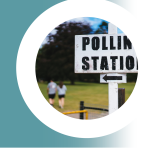
Dr Hannah Bunting
Co-director of The Elections Centre at the University of Exeter where she is a Lecturer in Quantitative British politics. She is also a Sky News elections analyst. Her work looks at the competitiveness of British elections, examining how the changing party system impacts both voters and the results of elections. She has also published work on political trust and gender in politics.
Email: h.bunting@exeter.ac.uk

UK Election 2024
Section 2: Voters, polls and results
13. Forecasting a multiparty majoritarian election with a volatile electorate (Dr Hannah Bunting)
14. The emerging infrastructure of public opinion (Dr Nick Anstead)
15. A moving target? Voter segmentation in the 2024 British General Election (Prof Rosie Campbell)
16. Don’t vote, it only encourages them? Turnout in the 2024 Election (Prof Charles Pattie)
17. Cartographic perspectives of the 2024 General Election (Prof Benjamin Hennig)
18. Gender and vote choice: early reflections (Dr Ceri Fowler)
19. Changing Pattern amongst Muslim voters: the Labour Party, Gaza and voter volatility (Dr Parveen Akhtar)
20. Religion and voting behaviour in the 2024 General Election (Dr Ekaterina Kolpinskaya, Dr Stuart Fox)
21. Failure to connect: the Conservative Party and young voters (Dr Stephanie Luke)
22. Youthquake for the progressive left: making sense of the collapse of youth support for the Conservatives (Prof James Sloam, Prof Matt Henn)
23. Values in the valence election (Prof Paula Surridge)
24. Tactical voting: why is it such a big part of British elections? (Thomas Lockwood)
The 2024 General Election seemed like a foregone conclusion, but in reality it was fuelled with uncertainty. The UK has a majoritarian electoral system, colloquially known as First Past the Post (FPTP), which has long been theorised should always produce a two-party system and for decades this proved at least close to correct. However, this began to break down in the 21st Century as more and more parties rose to prominence, gaining both votes and seats in the House of Commons. This coincided with a decline in partisanship and participation, that is citizens having weaker ties to politics, parties and politicians. The culmination of these factors occurred at this election.
Opinion polls play an increasingly important part in elections now that we live in a data-driven world. Dr Mark Pack’s PollBase records 30 standard vote intention (VI) polls in the six-week 2024 campaign, meaning there were five each week, from 13 different polling companies. These give a projected share of the vote for each party. In addition, there were numerous MRP polls – multilevel regression with post-stratification – which estimated the number of seats each party would get. Every time one was released, there would be media headlines from almost every major outlet, and they significantly impacted the narrative of the campaign.
On the 22nd May when the election was called, the VI polls stood at 21% Conservative, 46% Labour, 9% Liberal Democrat, 7% Green, 12% Reform, 3% SNP and 2% others. On the eve of polling day, the Conservatives were up 2%, Labour down 5%, Liberal Democrats up 2%, Greens no change, Reform up 3%, SNP down 1% and others down 1%. There was movement in between but largely within the margin of error that comes with polls. Yet notice the number of parties that needed a vote share estimation – five mainstream parties stood in 90% of constituencies at this election, plus the SNP in all of Scotland and Plaid Cymru in all of Wales. There were more candidates than ever before. In itself, that makes forecasting more difficult because it reduces the certainty in the point estimates for each party, and it becomes even more challenging when that vote share is spread across a majoritarian seat where only one person can win the contest for MP.
When it came to MRP polls which do just that, the average number of seats the Conservatives were expected to get was 95, with a 73 seat range of 53-126. Labour’s was 452 with an almost hundred seat range 418-516. The ranges became smaller as the parties did, Liberal Democrats at 59 (38-72), Reform at 3 (0-7), Greens at 2 (0-4) and the SNP 17 (8-29). The reason for this variation is the extent of voter volatility, that is citizens changing the party they vote for (or say they’ll vote for) between elections and even between polls. There was also a high number of people who were undecided right up until polling day and fewer people who were certain they’d turn out to vote at all. Pollsters had to make decisions on how to treat all of these factors, the likes of which had not been seen before.
It meant that there were nearly a quarter of seats (151 out of 632) on average where the forecasted margin for the winner was less than 5%. That’s almost three times higher than the actual number of marginals in 2019. Therefore, any small changes in responses from those surveyed, or in polling methods, resulted in a different party being allocated those seats as winners, ultimately altering the predictions substantially.
The Conservatives falling to less than a quarter of votes also meant there were no safe Tory seats. That is, there wasn’t a seat where they had a 100% probability of winning. Even Rishi Sunak’s own seat of Richmond & Northallerton gave him a 20% probability he’d lose. Uncertainty was rife even though Labour were projected to be by far the biggest winner.
In the end, the results show that forecasts overestimated Labour’s success, and underestimated the Conservatives’ and Liberal Democrats’ seats. They were correct on SNP share but not seats. There were 109 seats won with a margin less than 5%. Labour won a landslide majority on just a third of all votes. It highlights that FPTP behaves in unpredictable ways when there are multiple parties and a volatile electorate. Pollsters did pretty well considering. Yet the polls do raise a question about the role they play in election campaigns. Turnout was down more than 7 points to just 60%, one point off the lowest we’ve seen. It might be that the polls saying the election was sewn up, when actually each individual vote mattered more in this contest, meant that people stayed home. It’s something for us all to reflect on.
